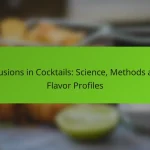In the world of mixology, the contrast between classic and modern techniques reveals a fascinating evolution of cocktail crafting. While classic mixology prioritizes traditional methods and high-quality ingredients, modern mixology embraces innovation and sustainability, pushing the boundaries of flavor and presentation. This blend of old and new not only enhances the drinking experience but also reflects changing consumer preferences and values.

What are the key differences between classic and modern mixology?
The key differences between classic and modern mixology lie in their approaches to recipes, techniques, and tools. Classic mixology emphasizes traditional methods and established recipes, while modern mixology embraces innovation, creativity, and advanced technology.
Classic techniques focus on traditional recipes
Classic mixology is rooted in time-honored recipes that have stood the test of time, such as the Martini, Old Fashioned, and Manhattan. These drinks often rely on a few high-quality ingredients, showcasing the balance of flavors and the skill of the bartender.
When using classic techniques, bartenders prioritize precision and consistency, often following specific ratios and methods. This approach ensures that each drink maintains its intended flavor profile, appealing to those who appreciate the art of traditional cocktail making.
Modern mixology emphasizes innovation and creativity
Modern mixology encourages experimentation and the use of unconventional ingredients, such as flavored bitters, unique syrups, and fresh herbs. Bartenders often create signature cocktails that reflect current trends and personal flair, pushing the boundaries of traditional recipes.
This innovative approach can include techniques like molecular mixology, which uses scientific principles to create new textures and flavors in drinks. The emphasis on creativity allows for a more personalized drinking experience, appealing to adventurous consumers.
Classic tools include shakers and muddlers
Classic mixology relies on traditional tools such as shakers, muddlers, jiggers, and strainers. These instruments are essential for crafting well-balanced cocktails, allowing bartenders to mix, muddle, and measure ingredients accurately.
Using these classic tools, bartenders can create a wide range of drinks while maintaining the integrity of the original recipes. Mastery of these tools is crucial for anyone looking to excel in traditional cocktail preparation.
Modern tools incorporate advanced technology
In contrast, modern mixology often utilizes advanced tools and gadgets, such as sous-vide machines, carbonation systems, and precision scales. These innovations enable bartenders to experiment with flavors and textures in ways that were previously not possible.
For example, a carbonation system can infuse cocktails with bubbles, while sous-vide allows for precise temperature control when infusing spirits. These tools not only enhance the creativity of the cocktails but also streamline the preparation process, making it more efficient.

How do classic mixology techniques enhance cocktail flavor?
Classic mixology techniques enhance cocktail flavor by emphasizing the quality of ingredients and precise preparation methods. These time-honored practices focus on balancing flavors and showcasing fresh, high-quality components, resulting in cocktails that are both nuanced and satisfying.
Use of fresh ingredients in classic cocktails
Fresh ingredients are a cornerstone of classic cocktails, significantly impacting the overall taste and aroma. Using seasonal fruits, herbs, and spices allows bartenders to create vibrant flavors that pre-packaged mixers cannot replicate. For instance, a classic Mojito benefits from freshly muddled mint and lime, which provide a bright and refreshing profile.
When selecting fresh ingredients, consider sourcing from local markets to ensure peak flavor and quality. Aim for ingredients that are in season, as they are often more flavorful and aromatic, enhancing the cocktail experience.
Balance of flavors through traditional methods
Traditional mixology methods, such as shaking, stirring, and muddling, are designed to achieve a harmonious balance of flavors. Techniques like shaking aerate the drink, blending ingredients thoroughly, while stirring maintains a silky texture without diluting too quickly. This balance is crucial for cocktails like the classic Martini, where the interplay of gin and vermouth must be precise.
To master flavor balance, pay attention to the ratios of sweet, sour, and bitter components. A common rule of thumb is the 2:1:1 ratio for sours, which combines two parts spirit, one part sour, and one part sweet. Experimenting within this framework can lead to well-rounded cocktails that appeal to a wide range of palates.
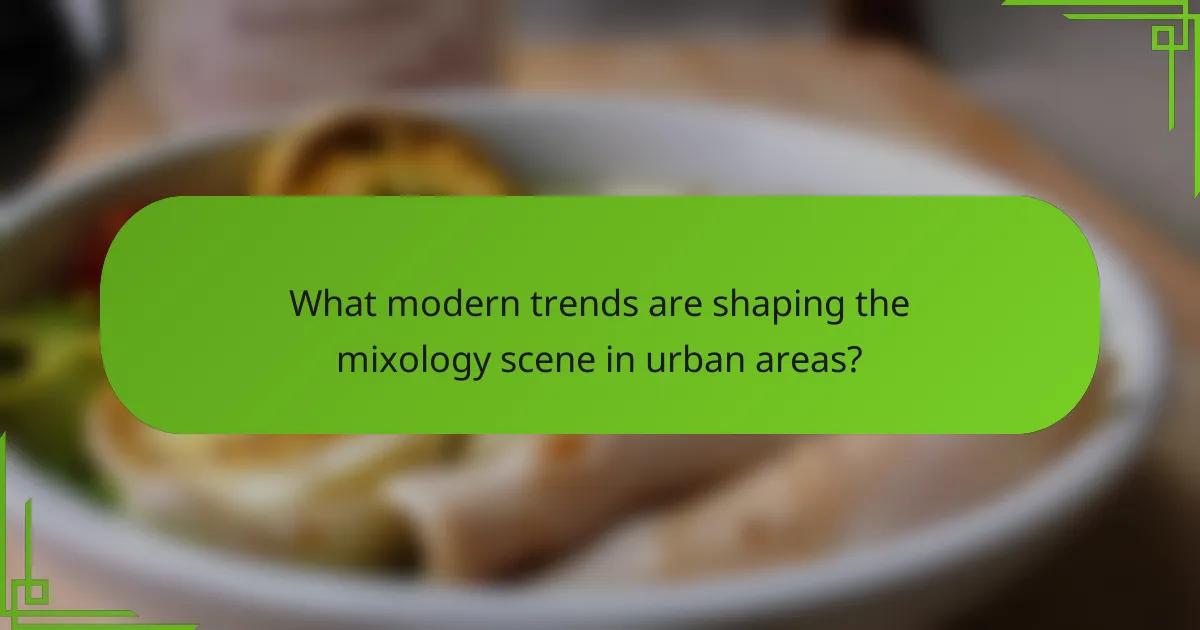
What modern trends are shaping the mixology scene in urban areas?
Modern trends in urban mixology are increasingly focused on creativity, sustainability, and local sourcing. Bartenders are experimenting with unique flavor profiles and eco-friendly practices to enhance the cocktail experience while appealing to a more conscientious clientele.
Craft cocktails with local ingredients
Using local ingredients in craft cocktails not only supports regional agriculture but also enhances the freshness and flavor of drinks. Bartenders are sourcing fruits, herbs, and spirits from nearby farms and distilleries, creating a unique taste that reflects the local culture.
For example, a cocktail might feature locally distilled gin infused with herbs from a nearby garden or seasonal fruits from local markets. This approach not only elevates the drink but also fosters a connection between the consumer and the community.
Focus on sustainability and eco-friendly practices
Sustainability is a key focus in modern mixology, with many bars adopting eco-friendly practices to reduce waste and minimize their environmental impact. This includes using biodegradable straws, composting organic waste, and sourcing ingredients from sustainable suppliers.
Additionally, bartenders are increasingly mindful of their water usage and energy consumption. Implementing practices like batch mixing and using energy-efficient equipment can significantly lower a bar’s carbon footprint while maintaining high-quality cocktails.
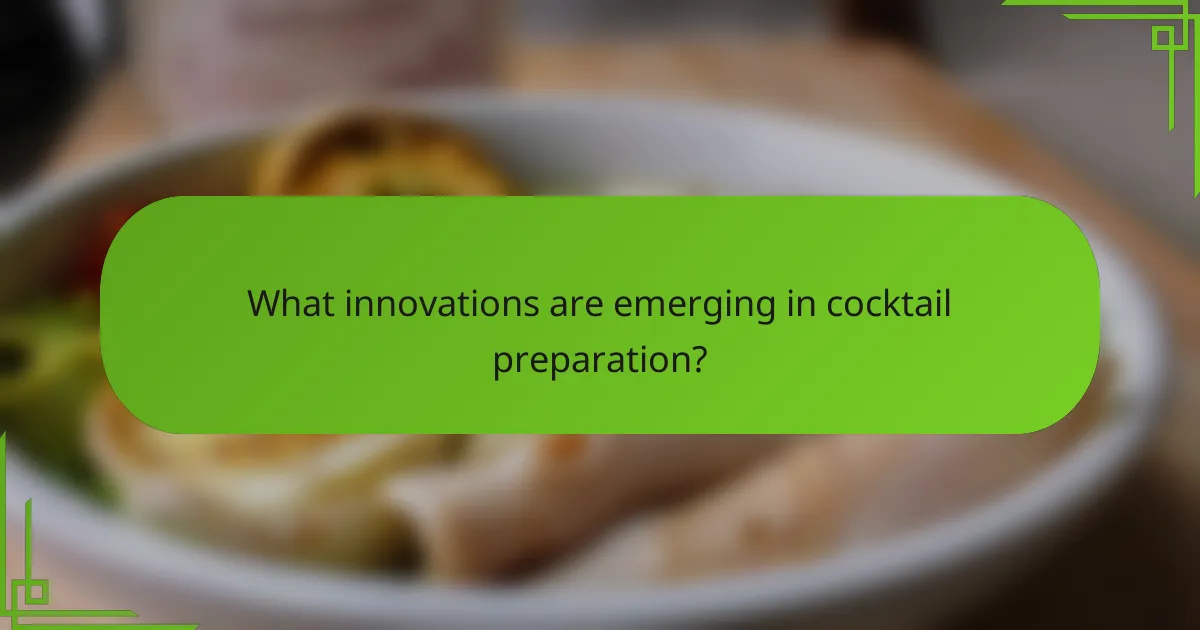
What innovations are emerging in cocktail preparation?
Innovations in cocktail preparation are transforming the way drinks are crafted, focusing on enhancing flavors and experiences. Techniques such as molecular gastronomy and automation are leading the charge, allowing bartenders to create unique and precise cocktails with greater efficiency.
Use of molecular gastronomy in cocktails
Molecular gastronomy involves applying scientific principles to mixology, resulting in innovative textures and flavors. Techniques such as spherification, foaming, and gelification can create visually stunning and flavorful cocktails that engage the senses in new ways.
For example, a classic mojito can be reimagined with mint caviar, where mint-infused liquid is transformed into tiny spheres that burst with flavor. Bartenders should experiment with these techniques while ensuring that the core flavors remain balanced and appealing.
Integration of automation in cocktail mixing
Automation in cocktail mixing streamlines the preparation process, allowing for consistency and speed. Machines can measure ingredients with precision, reducing the potential for human error and ensuring that each drink meets the same standard.
Automated cocktail dispensers can serve drinks in just a few seconds, making them ideal for high-volume venues. However, bartenders should still maintain a personal touch, as the art of mixology involves creativity and interaction that machines cannot replicate.
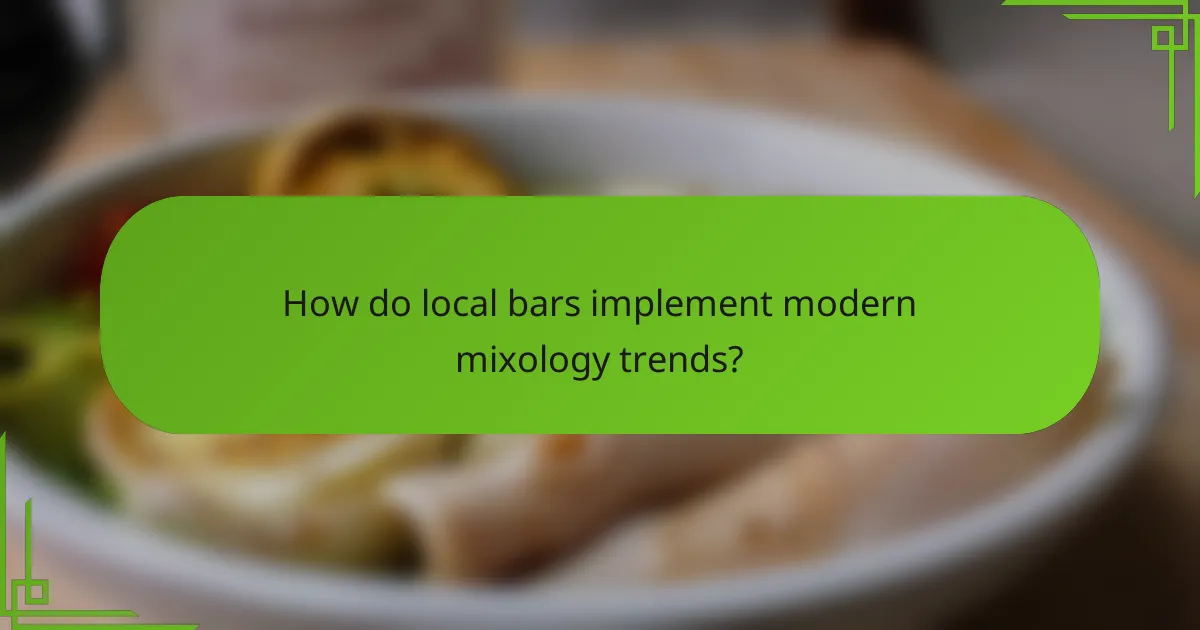
How do local bars implement modern mixology trends?
Local bars implement modern mixology trends by embracing innovative techniques and ingredients that enhance the drinking experience. This often involves incorporating seasonal ingredients, collaborating with local producers, and experimenting with new presentation styles.
Seasonal menus featuring local flavors
Many bars now create seasonal menus that highlight local flavors, using ingredients sourced from nearby farms and markets. This approach not only supports local agriculture but also ensures that cocktails are fresh and reflective of the region’s culinary identity.
For example, a bar in the Pacific Northwest might feature cocktails made with locally distilled spirits, fresh berries, and herbs from local gardens during the summer months. This practice can attract customers looking for unique, place-based experiences.
Collaboration with local distilleries
Collaboration with local distilleries is a growing trend in modern mixology, allowing bars to offer exclusive cocktails made with unique, handcrafted spirits. These partnerships often result in limited-edition drinks that showcase the distinct characteristics of local distillation processes.
Bars can benefit from these collaborations by hosting tasting events or cocktail classes, which not only promote the local distillery but also engage customers in the mixology process. This strategy can enhance customer loyalty and create a vibrant community around local spirits.
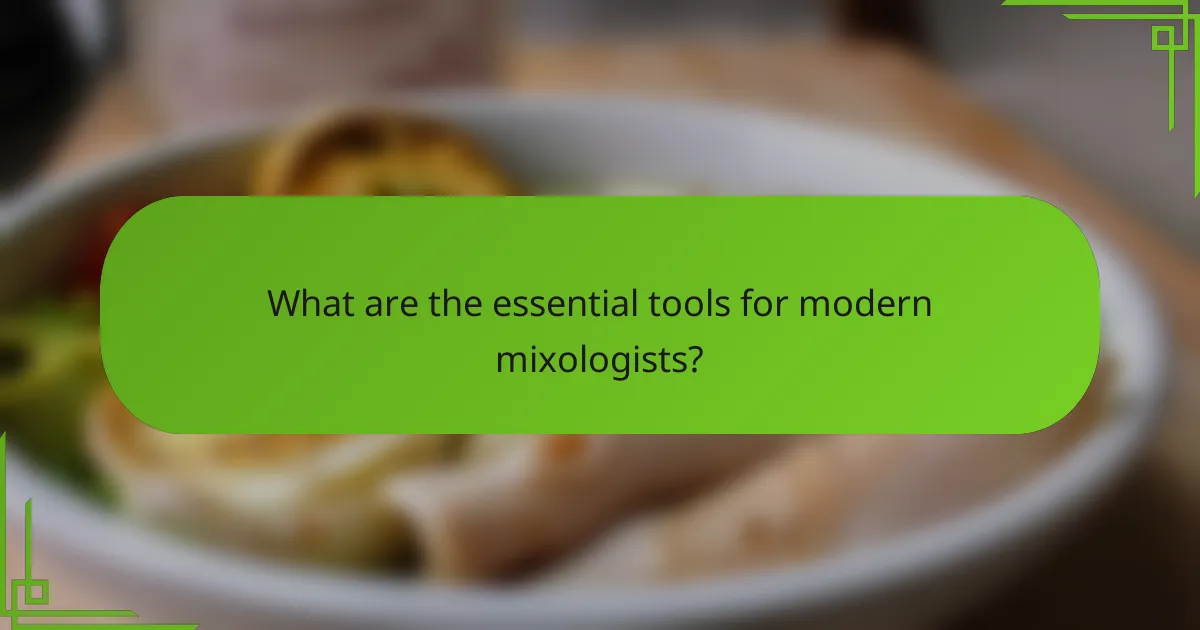
What are the essential tools for modern mixologists?
Modern mixologists rely on a variety of specialized tools to enhance their cocktail-making process. These tools not only improve precision and efficiency but also elevate the overall drinking experience.
Precision jiggers for accurate measurements
Precision jiggers are essential for ensuring accurate measurements of spirits and mixers in cocktail preparation. They typically feature dual-sided designs, allowing for quick measurement of different volumes, often ranging from 0.5 oz to 2 oz.
Using jiggers helps maintain consistency in drink recipes, which is crucial for both taste and presentation. When selecting a jigger, look for one made of durable materials like stainless steel, which can withstand frequent use and cleaning.
Smoking guns for flavor infusion
Smoking guns are innovative tools that allow mixologists to infuse cocktails with rich, smoky flavors. They work by generating smoke from wood chips, which can then be directed into a glass or cocktail shaker to enhance the drink’s aroma and taste.
When using a smoking gun, it’s important to experiment with different types of wood chips, such as hickory or applewood, to achieve various flavor profiles. Keep in mind that a little smoke goes a long way; start with short bursts to avoid overpowering the drink.
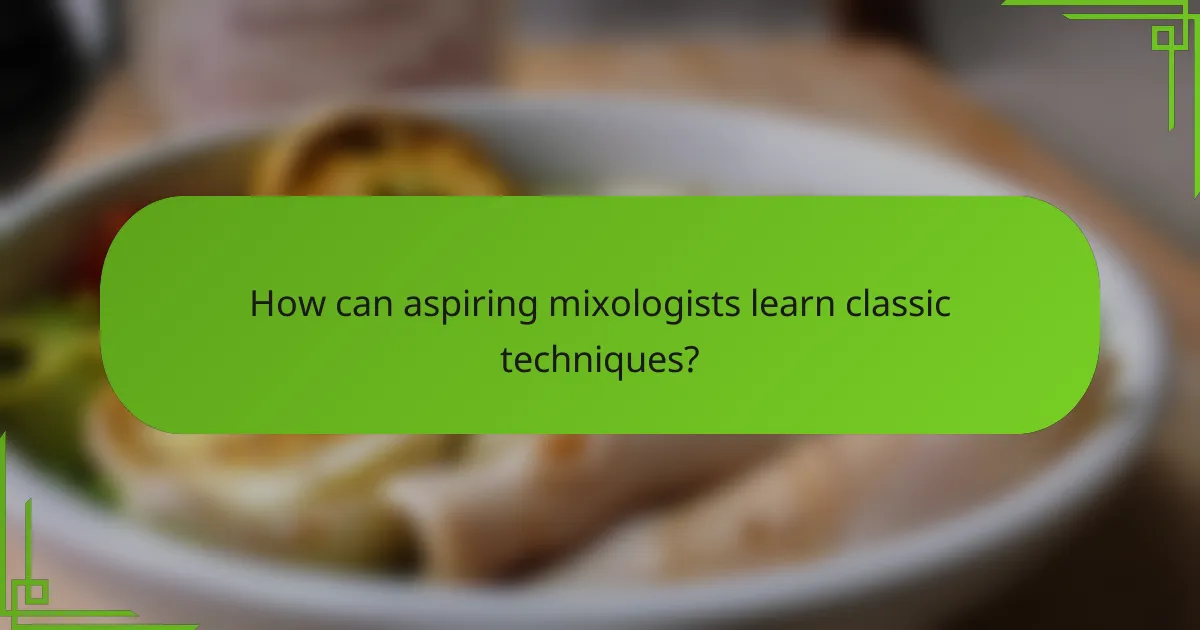
How can aspiring mixologists learn classic techniques?
Aspiring mixologists can learn classic techniques through structured education and hands-on experiences. By enrolling in bartending schools and attending workshops, they can gain essential skills and knowledge needed to master traditional mixing methods.
Enroll in local bartending schools
Local bartending schools offer comprehensive courses that cover classic mixology techniques, cocktail history, and customer service skills. These programs typically last from a few weeks to several months, providing both theoretical knowledge and practical training.
When choosing a bartending school, consider factors like the curriculum, instructor experience, and job placement assistance. Many schools also offer flexible schedules, making it easier for aspiring mixologists to balance their studies with other commitments.
Attend workshops and tastings
Workshops and tastings provide an interactive way to learn classic mixology techniques. These events often focus on specific skills, such as muddling, shaking, or garnishing, allowing participants to practice under the guidance of experienced bartenders.
Look for local bars or culinary schools that host workshops. Participating in tastings can also enhance your palate and understanding of flavor profiles, which is crucial for creating balanced cocktails. Networking with industry professionals during these events can lead to valuable mentorship opportunities.

